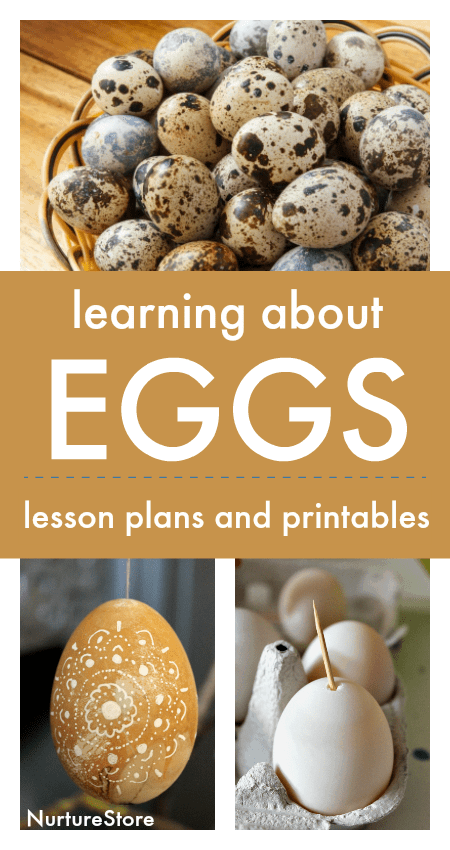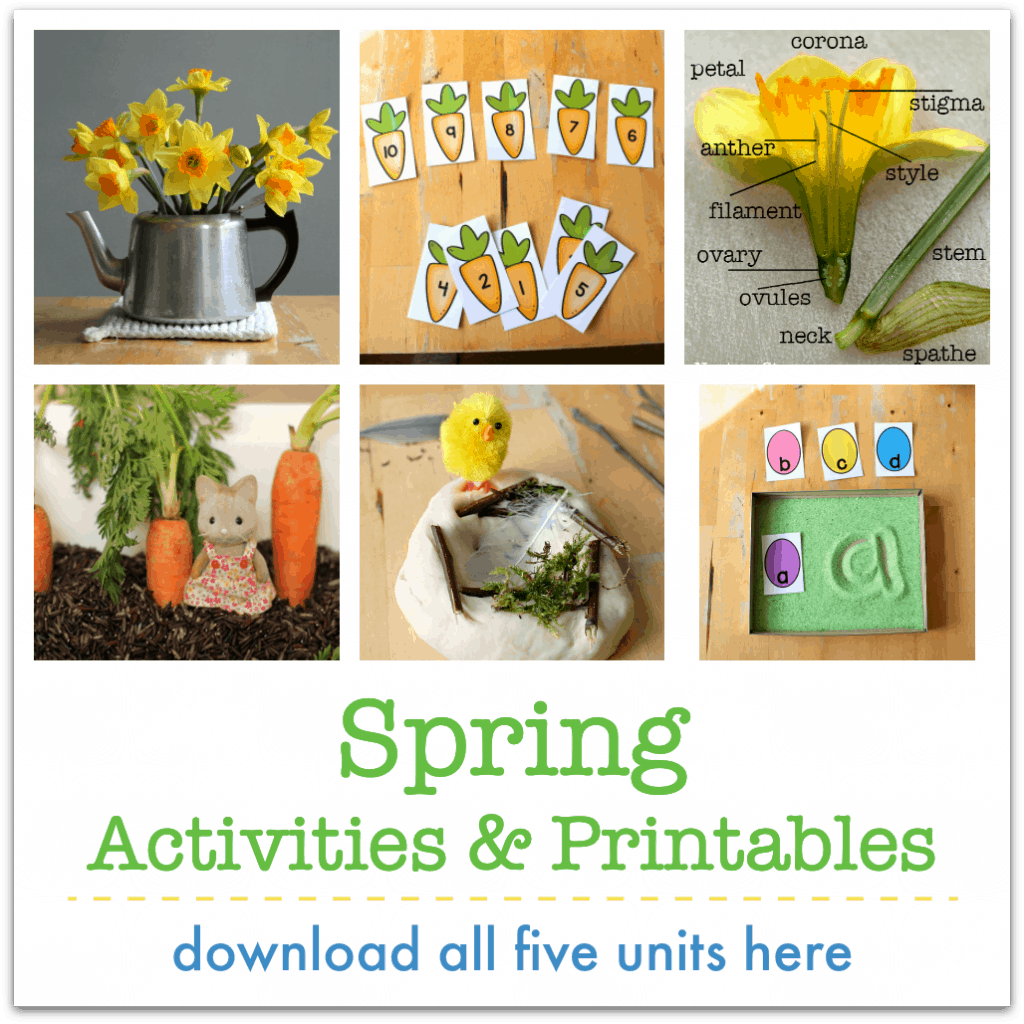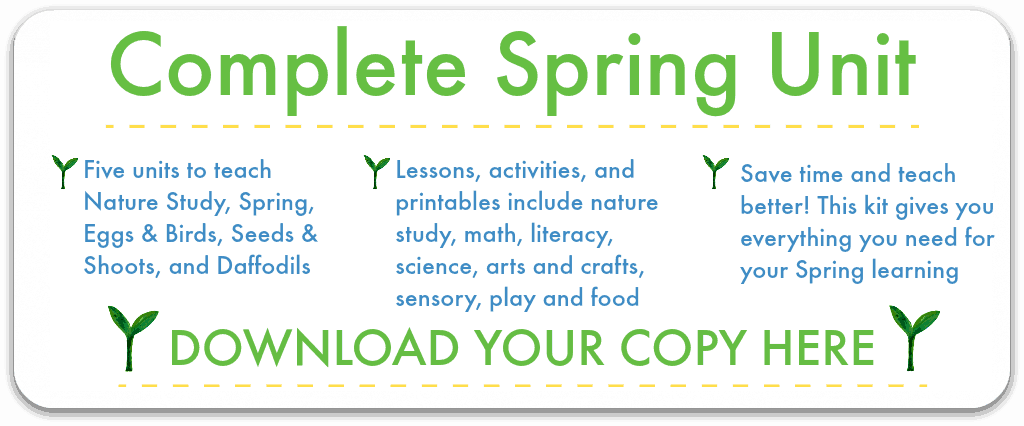In this egg lesson plan we’ll learn: what are eggs? what are eggs made of? and which animals hatch form eggs? You can watch a chick develop inside an egg and hatch, plus there’s a printable book about eggs that your children can complete.

What are eggs? lesson plan
Let’s Learn About Eggs
You can find my complete Eggs and Birds Unit here.
Today let’s investigate eggs. It’s useful if you have a chicken egg to explore. We’ll be reading, writing and talking about eggs: what they are, what they do, and why they are special to us.
I Wonder What An Egg Is?
Eggs are laid by birds, reptiles, fish, and invertebrates. The egg provides a safe home for the baby animal which is developing inside, until it is ready to hatch and survive on its own.
Eggs can be laid in water or on land. Some animals build a nest and lay their eggs inside.
Eggs can have a hard outer shell, and some are soft and leathery.
Female animals lay eggs, but both the mother and father birds may take turns to incubate their eggs, keeping them warm until they are ready to hatch. Some male animals, such as seahorses and leafy sea dragons, have a special brood pouch in their body where they incubate and take care of the eggs until they are ready to hatch.
You can see the varied colours and sizes of some common bird eggs here, and from birds around the world here. Look how the emu egg is different to the calliope hummingbird!
I Wonder What An Egg Is Made Of?
A chicken egg is made of different parts. Have you got one you can have a look at? Take care not to get any raw egg in your mouth, and wash your hands after investigating it.
What words can you think of to describe an egg?
Take a look at your egg: what does it look like outside? How does it feel?
Crack open your egg over a dish: what does it look like inside? How does it feel?
You can sketch your egg and make some notes in your nature journal.
The shell is made of calcium carbonate which has the chemical symbol CaCO3. There are thousands of pores on the egg shell which let air and moisture pass through.
The bloom on the outer coating of the egg helps keep bacteria out.
There is a thin membrane inside the egg. Can you peel it off from your shell?
You might see an air cell at the rounded end of your egg.
The egg white is called the albumen. It is a good source of protein.
The egg yoke might be pale yellow or deep orange, depending on the breed of hen and what she ate.
You might be able to see a chalaza, which is a twisted chord inside the egg white which holds the yolk centred within the egg. The more prominent the chalazae, the fresher the egg.
I Wonder What Happens Inside An Egg?
Join my Eggs and Birds Unit in the Seasons School Spring Curriculum to access all the lessons plans, activities ,and printables.
We’ll learn:
:: what happens inside an egg
:: which animals hatch from eggs
:: fun facts about eggs
:: how a chicken takes care of her chicks
:: why eggs are so special to us, culturally and spiritually
:: plus you’ll receive printables to support your learning, including the mini egg book
Click here to get your copy of the complete Eggs and Birds lesson.
Mini book printable: My Book of Eggs
You’ll find this mini book printable in my Eggs and Birds Unit and can add it to your nature journal to remind you what you have learned today.
In the mini book you can:
:: re-cap keys points about eggs
:: add your own illustrations
How to make the mini book
The mini book will fold up into a pop-out/French fold book. It’s easier than it sounds! Here’s a visual guide. You need to fold and cut it out as follows:
1. Print off the mini book pdf from the Eggs and Birds Unit.
2. Cut out all the way around the outside rectangular edge of the book, to trim off the white edge.
3. Fold your book along the light lines to divide the printable between the pages.
4. Cut a slit along the thicker black line in the centre of the printable.
5. Fold your book in half along the long central line, and then fold the pages. As you do so, pull the inner pages out, giving you your folded book.
6. You can read your book and add your own notes and illustrations to it. You can stick a pocket into your nature journal and keep your mini book inside.
(Egg photo courtesy of Piyachok Thawornmat via FreeDigitalPhotos.net.)

Download all the Spring units and printables
Download our complete Spring lesson plans, activities and printables and your spring teaching will be so easy!
:: five complete units of ebooks and printables for Nature Study, Welcome Spring, Daffodils, Seeds and Shoots, and Eggs and Birds
:: over 50 engaging activities and lesson plans that your children will love
:: over 30 pages of printables that make teaching so easy
:: a balanced programme of math, science, literacy, arts and crafts, nature study, sensory and imaginative play
:: a practical resource that you can start using today, in class or at home
:: weeks worth of learning all planned for you, to take you right through the season
:: created with children aged 4 to 8 in mind
You're going to love this super useful resource!
CLICK HERE to see more and get your spring resource kit.




